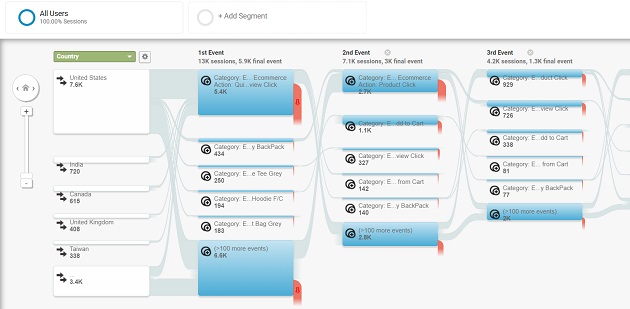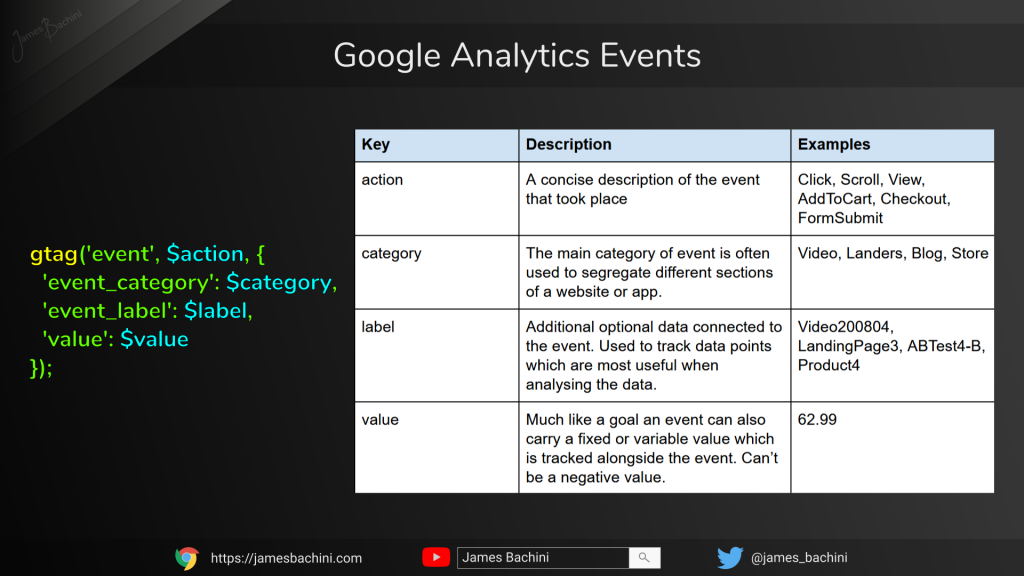Google Analytics Event Tracking - An Overview
An Unbiased View of Google Analytics Event Tracking
Table of ContentsGoogle Analytics Event Tracking for DummiesGoogle Analytics Event Tracking for BeginnersSome Ideas on Google Analytics Event Tracking You Need To KnowThe Best Guide To Google Analytics Event TrackingIndicators on Google Analytics Event Tracking You Should KnowExcitement About Google Analytics Event Tracking

If you're mosting likely to establish event tracking by hand, after that you're mosting likely to have to include some additional code to the elements you desire to collect data from. The code you're mosting likely to work with will look something similar to this: There are four parts within that code snippet that you're going to require to define yourself: event, Group, occasion, Activity, event, Tag and event, Value.
As you can see, two of these are called for (group and activity) while label and worth are optional. Everything relies on the type of details you want communicated back to Google Analytics when an individual clicks on the specified component (Google Analytics Event Tracking). It will certainly be a lot easier to specify these parts if you evaluate your website and choose which elements/actions you wish to track
Google Analytics Event Tracking for Dummies
Now, you'll be asked to define the and and you'll want to pick from the drop-down food selection that shows up when you click. This will raise the same event tracking parts we considered earlier, which you'll require to complete. Once you've specified these, you can move down to the 2nd box and select the trigger that will terminate your tag.
On the next screen, you'll additionally have a field for calling your trigger and, if you click package, you'll see a listing of the different triggers you can select. In this instance, we wish to select and after that choose the choice listed below. You'll set the trigger to just terminate when a component is clicked with a Link that has the.
Every site talks. Before data analytics, we couldn't hear the voices of our web sites. Exactly how do you recognize what your web site is claiming? Simple - Occasion monitoring! Event monitoring provides you an image of how individuals involve with your site and business (Google Analytics Event Tracking). Do you would like to know even more? Then, Visit Website continue reading as we explore every little thing you require to understand, including what it is, why you ought to track events, exactly how to handle occasions data, and other appropriate FAQs you may have.
Some Known Questions About Google Analytics Event Tracking.
You can switch between your occasion categories, actions, and tags in the Leading Events report. The Occasion Pages report displays the web pages where events are triggered.
It shows you the path they take as they relocate from one occasion to the following and helps you to determine which content engages your target market the many. Events in Google Analytics have 4 major aspects. They are also a part of the event tracking code. Google Analytics utilizes these codes to track customer interactions and group them into event records.
A checklist of the more tips here criteria you can track on your web site is on the. After examining all essential areas, you can click "X" to close the window and return to the Introduction food selection on the.
The Of Google Analytics Event Tracking

Choosing "False" will certainly stop that session from being a bounce. If you have not done so, you may require to establish a variable in the Google Analytics Settings box. Click "New Variable ..." if you can't discover one to pick. After this, enter your GA tracking ID in the Monitoring ID area.
Your ID will certainly be on top of the screen. To do view it this, comply with the following collection of activities: After setting up the areas, choose the "Triggering" section. When configuring your brand-new trigger, click the "+" switch, after that the "pencil" switch, after that select your trigger kind. Label your trigger and define the problems that lead to trigger firing.
Our Google Analytics Event Tracking Statements

When it familiarizes which areas and elements are directing consumers via your conversion channel, you still will not know. So, without event tracking, GA records will only count brows through as single-page sessions, even if customers spend a lot of time on one web page and engage with it considerably (and a bounce).
How does event tracking accomplish this?Single-web page sessions understood as bounces begin and end on the same web page. Without occasion tracking, GA will categorize a customer's visit as a bounce if they don't browse to another web page, regardless of just how they communicate with it. A video-rich web page can have a higher bounce rate if occasions are not tracked.
Get This Report about Google Analytics Event Tracking
For GA to take event hits into account when gauging bounce prices, you need to choose "Non-interaction event" as "False" during the GTM configuration. Establishing "occasion objectives" with event action is a superb method to monitor individual tasks you worth extremely, such as brand-new lead entries or clicks on a call to activity.